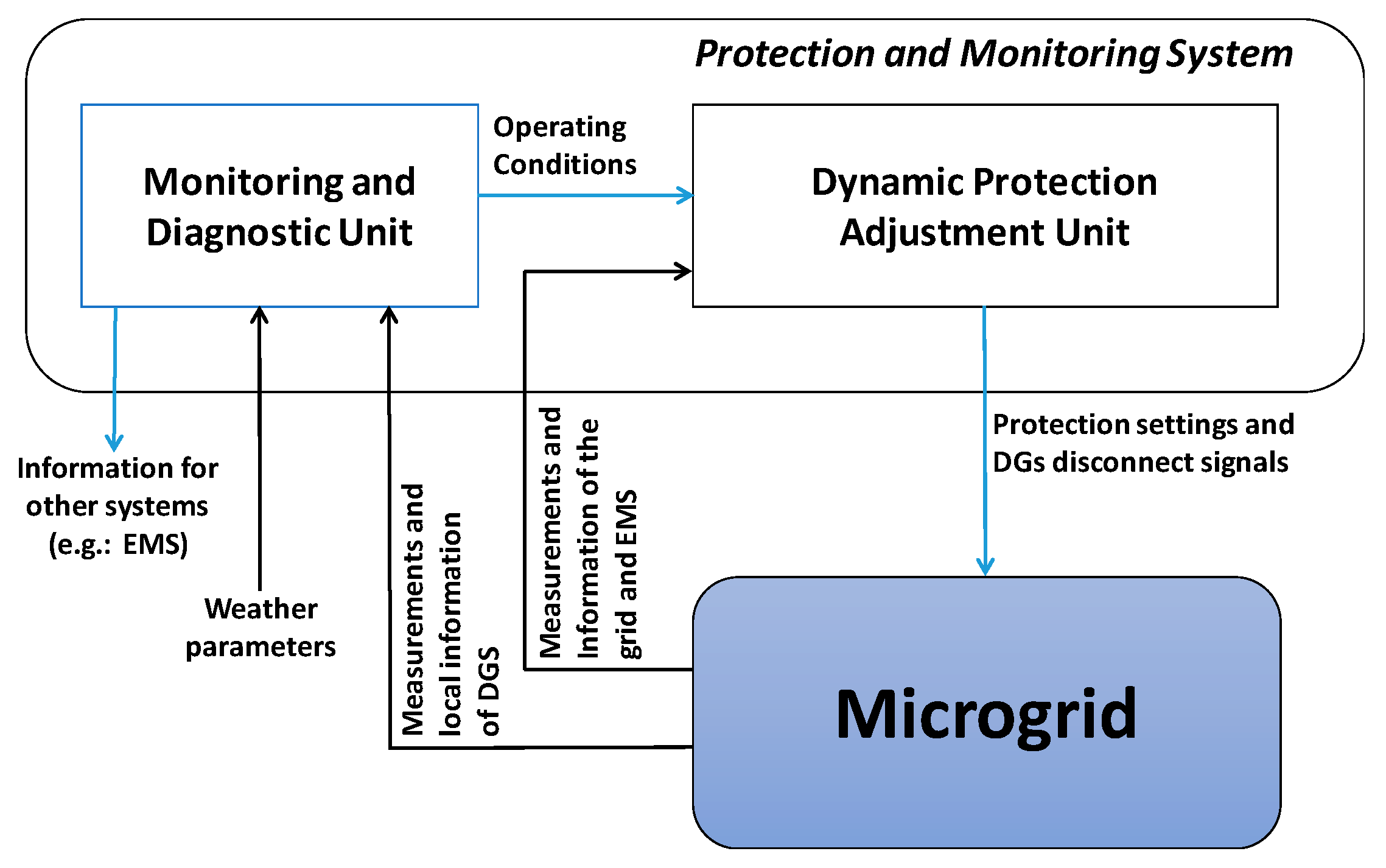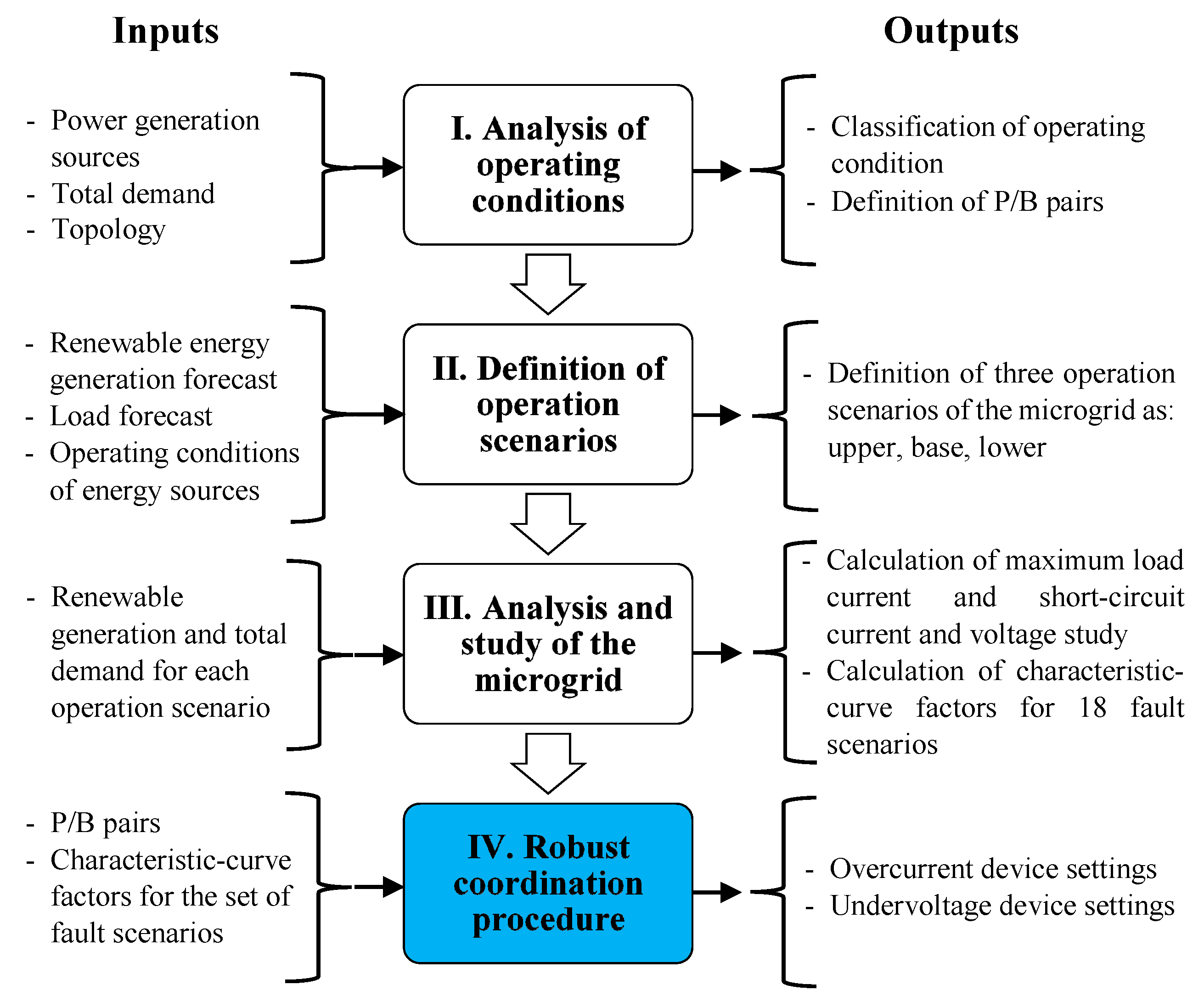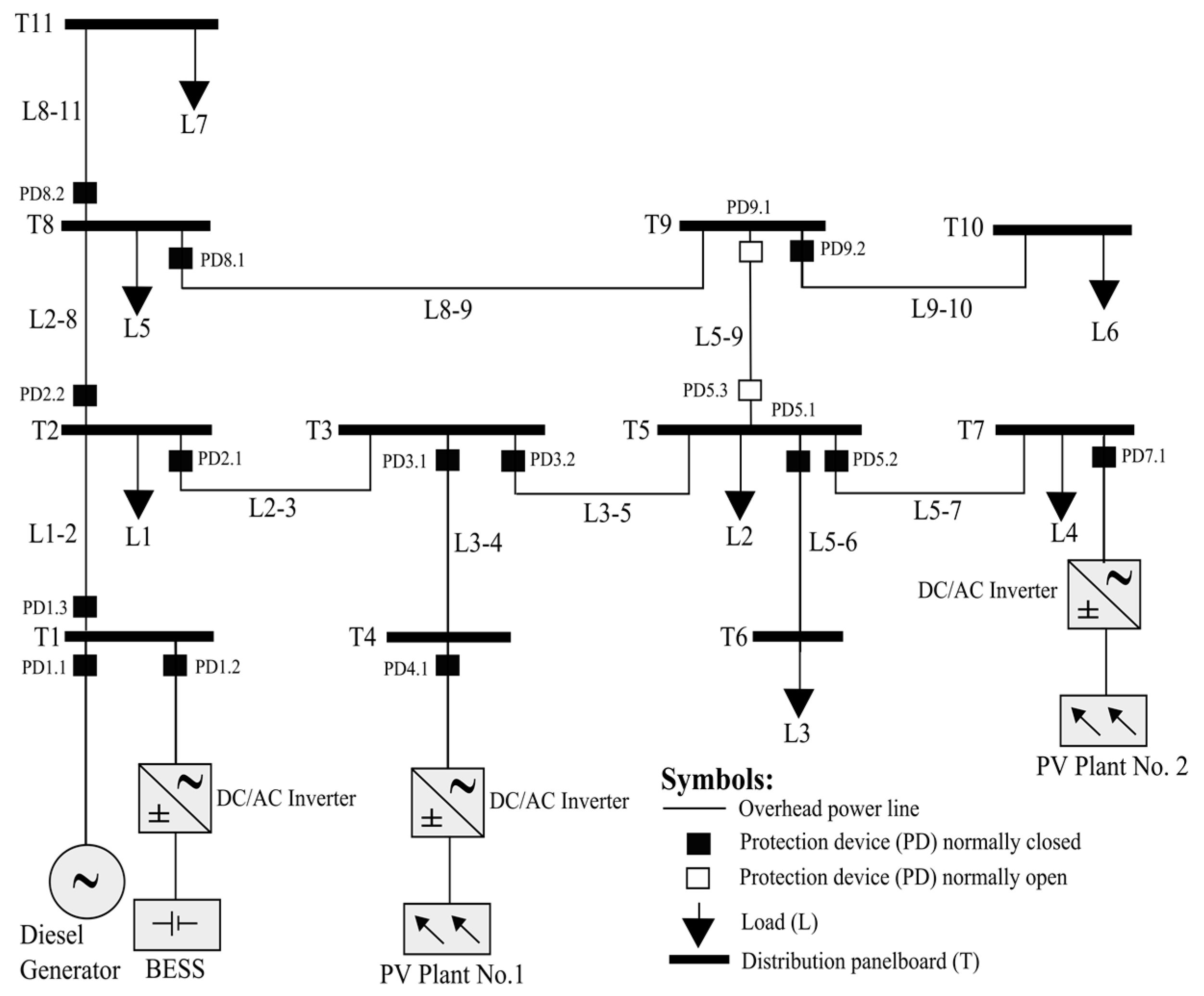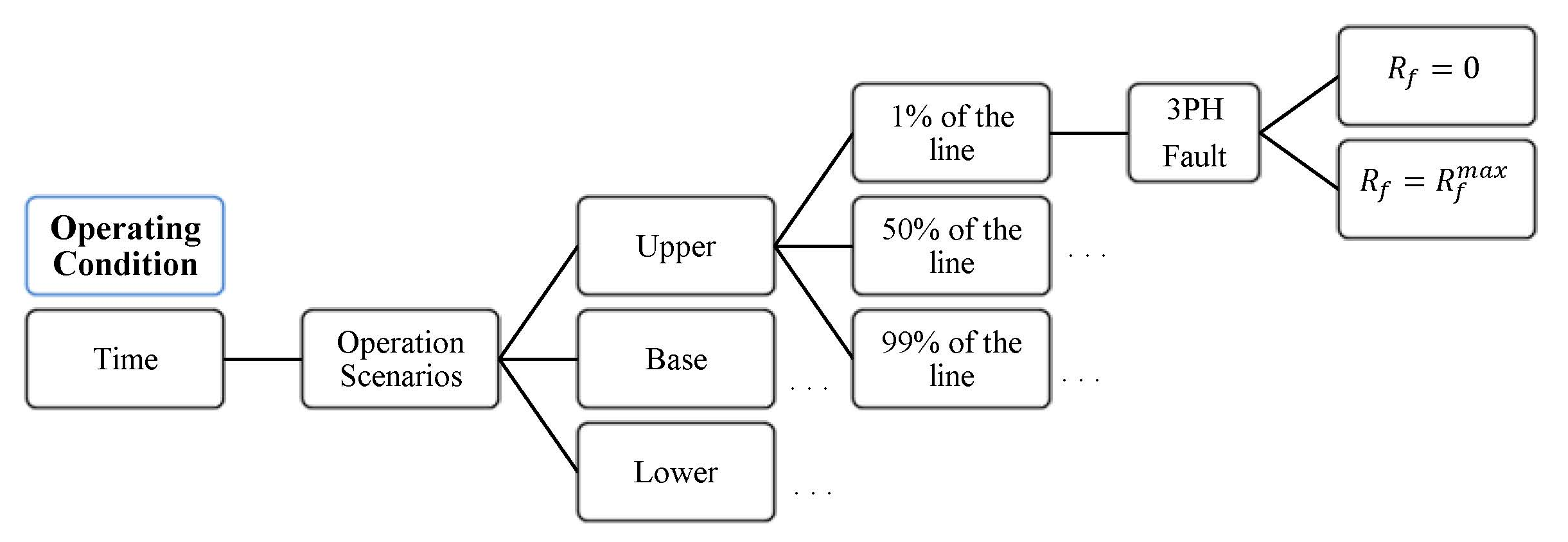Adaptive Protection System for Microgrids Based on a Robust Optimization Strategy
Abstract
:1. Introduction
- connection and disconnection of DG units and storage devices;
- changes in the operation mode of the microgrid (isolated, grid-connected);
- topology changes;
- load variations (intra-daily, daily, seasonal).
2. Formulation of the Robust Coordination Problem
3. Methodology Framework and Validation
3.1. Description of the Proposed Method
3.1.1. Analysis of Operating Conditions
- Changes in the operating mode.
- Changes in the DG units and energy storage systems.
- Changes in the topology.
- Changes in the net load parameter (), defined as follows:where is the total load and is the generation of renewable energy sources.
3.1.2. Definition of the Operation Scenarios
- Get the initial condition for .
- The DPAU asks for renewable generation and a load forecast for the next forecasting horizon . Several conventional forecasting methods can be applied for this purpose [23].
- For a defined confidence band, the following three different operation scenarios are considered: upper band limit, base, and lower band limit.
3.1.3. Analysis and Study of the Microgrid
3.1.4. Robust Coordination Procedure
3.2. Validation of the Methodological Proposal
3.3. Practical Considerations
- The first level comprises field devices, such as controllers, actuators, protective devices, and sensors, all of which are deployed on the entire microgrid. The controllers and actuators perform the control actions on the microgrid. The protective devices are adjustable and provide the remote trip capacity. The sensors are the main components for achieving accurate and reliable field data.
- The second level is the data acquisition layer, which channels the communications within the microgrid. It requires specific hardware and communication networks.
- The final level corresponds to the protection and monitoring system, where the procedures for diagnostics and adjustment of protective devices are executed. This is the realization of the MDU and DPAU.
- The use of microprocessor-based directional relays that include overcurrent and under voltage elements is necessary.
- The relays must have the possibility of using different tripping characteristics (i.e., several settings groups) that can be configured locally or remotely, automatically or manually.
- The use of a communication infrastructure that uses standard communication protocols is required. By doing so, individual relays can communicate and exchange information with the protection and monitoring system, or between different individual relays, in a fast and reliable manner, guaranteeing the required application performance.
4. Study Case and Results
4.1. Description of the ESUSCON Microgrid
4.2. Application of the Proposed Methodology and Discussion
- Operating condition at 2 p.m.: it is characterized by a low demand, which is supplied exclusively by the PV plants and the BESS is being charged. The Diesel generator is off. Thus, the NL parameter is classified as Low.
- Operating condition at 11 p.m.: it is characterized by high demand. This is supplied by the Diesel generator, and the BESS is being charged. The PV plants are off. Thus, the NL parameter is classified as High.
5. Conclusions
Acknowledgments
Author Contributions
Conflicts of Interest
Appendix A
| Line No. | R [Ω/km] | X [Ω/km] | Length [km] |
|---|---|---|---|
| L1-2 | 0.372 | 0.0890 | 0.0910 |
| L2-3 | 0.744 | 0.0930 | 0.0680 |
| L3-4 | 1.010 | 0.0965 | 0.178 |
| L3-5 | 0.744 | 0.0930 | 0.0250 |
| L5-6 | 1.010 | 0.0965 | 0.0440 |
| L5-7 | 0.744 | 0.0930 | 0.229 |
| L5-9 | 1.010 | 0.0965 | 0.0280 |
| L2-8 | 0.744 | 0.0930 | 0.0840 |
| L8-9 | 1.010 | 0.0965 | 0.148 |
| L8-11 | 1.010 | 0.0965 | 0.0370 |
| L9-10 | 1.010 | 0.0965 | 0.0890 |
References
- Oureilidis, K.; Demoulias, C. A fault clearing method in converter-dominated microgrids with conventional protection means. IEEE Trans. Power Electron. 2016, 31, 4628–4640. [Google Scholar] [CrossRef]
- Lasseter, R. MicroGrids. In Proceedings of the 2002 IEEE Power Engineering Society Winter Meeting, New York, NY, USA, 7–31 January 2002; Volume 1, pp. 305–308. [Google Scholar]
- Zeineldin, H.; Kanan, N.; Casagrande, E.; Woon, W. Data mining approach to fault detection for isolated inverter-based microgrids. IET Gener. Transm. Distrib. 2013, 7, 745–754. [Google Scholar]
- Tumilty, R.; Patrick, R.; Fardo, W. Approaches to network protection for inverter dominated wlectrical distribution systems. IET Int. Conf. Power Electron. Mach. Drives 2006, 622–626. [Google Scholar] [CrossRef]
- Kar, S.; Samantaray, S.; Zadeh, D. Data-Mining model based intelligent differential microgrid protection scheme. IEEE Syst. J. 2015, 11, 1161–1169. [Google Scholar] [CrossRef]
- Bui, D.; Lien, K.; Chen, S.; Lu, Y.; Chan, C.; Chang, Y. Investigate dynamic and transient characteristics of microgrid operation and develop a fast-scalable-adaptable algorithm for fault protection system. Electr. Power Syst. Res. 2015, 120, 214–233. [Google Scholar] [CrossRef]
- Brearley, B.; Prabu, R. A review on issues and approaches for microgrid protection. Renew. Sustain. Energy Rev. 2017, 67, 988–997. [Google Scholar] [CrossRef]
- Urdaneta, A.; Nadira, R.; Jimenez, L. Optimal coordination of directional overcurrent relays in interconnected power systems. IEEE Trans. Power Deliv. 1988, 3, 903–911. [Google Scholar] [CrossRef]
- Craparo, E.; Karatas, M.; Singham, D. A robust optimization approach to hybrid microgrid operation using ensemble weather forecasts. Appl. Energy 2017, 201, 135–147. [Google Scholar] [CrossRef]
- Albasri, F.; Alroomi, A.; Talaq, J. Optimal coordination of directional overcurrent relays using biogeography-based optimization algorithms. IEEE Trans. Power Deliv. 2015, 30, 1810–1820. [Google Scholar] [CrossRef]
- Bertsimas, D.; Litvinov, E.; Sun, X.; Zhao, J.; Zheng, T. Adaptive robust optimization for the security constrained unit commitment problem. IEEE Trans. Power Syst. 2013, 28, 52–63. [Google Scholar] [CrossRef]
- Zamani, M.; Sidhu, T. A protection strategy and microprocessor-based relay for low-voltage microgrids. IEEE Trans. Power Deliv. 2011, 26, 1873–1883. [Google Scholar] [CrossRef]
- Zarei, S.; Parniani, M. A comprehensive digital protection scheme for low voltage microgrids with inverter-based and conventional distributed generations. IEEE Trans. Power Deliv. 2017, 32, 441–452. [Google Scholar] [CrossRef]
- Sharaf, H.; Zeineldin, H.; El-Saadany, E. Protection coordination for microgrids with grid-connected and islanded capabilities using communication assisted dual setting directional overcurrent relays. IEEE Trans. Smart Grid 2018, 9, 143–151. [Google Scholar] [CrossRef]
- Ezzeddine, M.; Kaczmarek, R. A novel method for optimal coordination of directional overcurrent relays considering their available discrete settings and several operation characteristics. Electr. Power Syst. Res. 2011, 81, 1475–1481. [Google Scholar] [CrossRef]
- Jimenez, L.; Urdaneta, A. Optimal coordination of directional overcurrent relays considering definite backup relaying. IEEE Trans. Power Deliv. 1999, 14, 1276–1284. [Google Scholar]
- Saleh, K.; Zeineldin, H.; El-saadany, E. Optimal coordination of directional overcurrent relays using a new time–current–voltage characteristic. IEEE Trans. Power Deliv. 2015, 30, 537–544. [Google Scholar] [CrossRef]
- Saleh, K.; Zeineldin, H.; El-saadany, E. Optimal protection coordination for microgrids considering N−1 contingency. IEEE Trans. Ind. Inform. 2017, 13, 2270–2278. [Google Scholar] [CrossRef]
- Sutherland, P.E. Protective device coordination in an industrial power system with multiple sources. IEEE Trans. Ind. Appl. 1997, 33, 1096–1103. [Google Scholar] [CrossRef]
- Braga, A.; Saraiva, J. Coordination of overcurrent directional relays in meshed networks using the Simplex method. In Proceedings of the 8th Mediterranean Electrotechnical Conference on Industrial Applications in Power Systems, Computer Science and Telecommunications (MELECON 96), Bari, Italy, 16 May 1996; pp. 1535–1538. [Google Scholar]
- Boyd, S.; Vandenberghe, L. Convex Optimization; Cambridge University Press: Cambridge, UK, 2004. [Google Scholar]
- Nuñez, O.; Palma, R.; Valencia, F.; Mendoza, P.; Cotos, J. Integrated protection and monitoring system for safe operation of photovoltaic-based isolated microgrids. In Proceedings of the IEEE PES General Meeting, Chicago, IL, USA, 16–20 July 2017; pp. 1–5. [Google Scholar]
- Palma-Behnke, R.; Benavides, C.; Lanas, F.; Severino, B.; Reyes, L.; Llanos, J.; Sáez, D. A microgrid energy management system based on the rolling horizon strategy. IEEE Trans. Smart Grid 2012, 4, 996–1006. [Google Scholar] [CrossRef]
- Olivares, D.; Cañizares, C.; Kazerani, M. A centralized energy management system for isolated microgrids. IEEE Trans. Smart Grid 2014, 5, 1864–1875. [Google Scholar] [CrossRef]
- Boutsika, T.; Papathanassiou, S. Short-circuit calculations in networks with distributed generation. Electr. Power Syst. Res. 2008, 78, 1181–1191. [Google Scholar] [CrossRef]
- Nouri, H.; Terzija, V.V.; Rade, C. Improved fault analysis method based on a new arc resistance formula. IEEE Trans. Power Deliv. 2011, 26, 120–126. [Google Scholar]
- IEEE PES. Distribution Test Feeders. 37-Bus Feeder. 2000. Available online: http://ewh.ieee.org/soc/pes/dsacom/testfeeders/index.html (accessed on 23 August 2017).
- Alvial, C.; Garrido, N.; Jiménez, G.; Reyes, L.; Palma, R. A methodology for community engagement in the introduction of renewable based smart microgrid. Energy Sustain. Dev. 2011, 15, 314–323. [Google Scholar] [CrossRef]
- Núñez, O.; Valencia, F.; Palma, R.; Jiménez, G.; Cotos, J. Microgrids Protection Schemes (esquemas de protección para micro-redes). In Proceedings of the 2015 CHILEAN Conference on Electrical, Electronics Engineering, Information and Communication Technologies (CHILECON), Santiago, Chile, 28–30 October 2015; pp. 1–6. [Google Scholar]





| Bus No. | Primary Device | Current Pickup [A] | Voltage Pickup [V] | Backup Device | Settings with Proposed Methodology | Settings with Alternative Methodology | ||
|---|---|---|---|---|---|---|---|---|
| [s] | [s] | [s] | [s] | |||||
| 702 | 1 | 230 | 4080 | - | 0.14 | 0.47 | 0.22 | 0.40 |
| 703 | 1 | 160 | 4080 | 702-1 | 0.14 | 0.37 | 0.14 | 0.35 |
| 2 | 50 | 4080 | 0.05 | 0.13 | 0.05 | 0.12 | ||
| 709 | 1 | 120 | 4080 | 703-1 | 0.13 | 0.33 | 0.13 | 0.31 |
| 2 | 20 | 4080 | 0.05 | 0.12 | 0.05 | 0.12 | ||
| 3 | 45 | 4080 | 0.08 | 0.10 | 0.08 | 0.10 | ||
| 708 | 1 | 110 | 4080 | 709-1 | 0.10 | 0.26 | 0.10 | 0.25 |
| 2 | 20 | 4080 | 0.05 | 0.12 | 0.05 | 0.12 | ||
| 734 | 1 | 70 | 4080 | 708-1 | 0.08 | 0.20 | 0.08 | 0.20 |
| 2 | 25 | 4080 | 0.05 | 0.13 | 0.05 | 0.13 | ||
| 738 | 1 | 25 | 4080 | 734-1 | 0.05 | 0.14 | 0.05 | 0.14 |
| No. | Bus No. | Unit | Rated Power | Electrical Data and Others |
|---|---|---|---|---|
| 1 | T1 | Diesel generator | 120 [kW] | 220/380 [V], 3-phase, 50 [Hz], synchronous machine |
| 2 | T1 | BESS | 40 [kW] | 220/380 [V], 3-phase, 50 [Hz], with inverter |
| 3 | T4 | PV Plant #1 | 50 [kW] | 220/380 [V], 3-phase, 50 [Hz], with inverter |
| 4 | T7 | PV Plant #2 | 10 [kW] | 220/380 [V], 3-phase, 50 [Hz], with inverter |
| Bus No. | Main Device | Settings with Proposed Methodology (A)—11 p.m. | Settings with Proposed Methodology (A)—2 p.m. | Settings with Alternative Methodology (B)—2 p.m. | |||||
|---|---|---|---|---|---|---|---|---|---|
| [A] | [s] | [s] | [A] | [s] | [s] | [s] | [s] | ||
| T1 | PD1.3 | 125 | 0.11 | 0.16 | 70 | 0.07 | 0.17 | 0.06 | 0.14 |
| T2 | PD2.1 | 70 | 0.13 | 0.16 | 65 | 0.06 | 0.13 | 0.05 | 0.12 |
| PD2.2 | 45 | 0.09 | 0.15 | 35 | 0.11 | 0.14 | 0.09 | 0.11 | |
| T3 | PD3.1 | 65 | 0.05 | 0.10 | 65 | 0.05 | 0.03 | 0.05 | 0.02 |
| PD3.2 | 40 | 0.09 | 0.14 | 20 | 0.08 | 0.10 | 0.08 | 0.09 | |
| T5 | PD3.1 | 10 | 0.05 | 0.10 | 10 | 0.05 | 0.06 | 0.05 | 0.06 |
| PD3.2 | 30 | 0.05 | 0.10 | 15 | 0.05 | 0.07 | 0.05 | 0.06 | |
| T8 | PD8.1 | 55 | 0.06 | 0.13 | 30 | 0.09 | 0.13 | 0.06 | 0.09 |
| PD8.2 | 10 | 0.05 | 0.10 | 10 | 0.05 | 0.07 | 0.05 | 0.07 | |
| T9 | PD9.2 | 10 | 0.05 | 0.10 | 10 | 0.05 | 0.10 | 0.05 | 0.09 |
| Fault Type | Fault Resistance | Location on the Line Based on the Total Distance | |||||
|---|---|---|---|---|---|---|---|
| 1% | 50% | 99% | |||||
| Clearing Time with (A) [s] | Clearing Time with (B) [s] | Clearing Time with (A) [s] | Clearing Time with (B) [s] | Clearing Time with (A) [s] | Clearing Time with (B) [s] | ||
| 3PH | 0.114 (OC) | 0.117 (OC) | 0.115 (OC) | 0.117 (OC) | 0.115 (OC) | 0.118 (OC) | |
| 0.147 (OC) | 0.152 (OC) | 0.148 (OC) | 0.153 (OC) | 0.148 (OC) | 0.153 (OC) | ||
| L-L | 0.176 (OC) | 0.183 (OC) | 0.177 (OC) | 0.184 (OC) | 0.177 (OC) | 0.184 (OC) | |
| 0.107 (UV) | 0.094 (UV) | 0.108 (UV) | 0.094 (UV) | 0.108 (UV) | 0.095 (UV) | ||
| 2LG | 0.143 (OC) | 0.148 (OC) | 0.144 (OC) | 0.148 (OC) | 0.144 (OC) | 0.149 (OC) | |
| 0.169 (UV) | 0.149 (UV) | 0.175 (UV) | 0.155 (UV) | 0.178 (UV) | 0.158 (UV) | ||
| 1LG | 0.185 (OC) | 0.192 (OC) | 0.185 (OC) | 0.193 (OC) | 0.186 (OC) | 0.193 (OC) | |
| 0.228 (OC) | 0.241 (OC) | 0.229 (OC) | 0.241 (OC) | 0.229 (OC) | 0.242 (OC) | ||
© 2018 by the authors. Licensee MDPI, Basel, Switzerland. This article is an open access article distributed under the terms and conditions of the Creative Commons Attribution (CC BY) license (http://creativecommons.org/licenses/by/4.0/).
Share and Cite
Núñez-Mata, O.; Palma-Behnke, R.; Valencia, F.; Mendoza-Araya, P.; Jiménez-Estévez, G. Adaptive Protection System for Microgrids Based on a Robust Optimization Strategy. Energies 2018, 11, 308. https://doi.org/10.3390/en11020308
Núñez-Mata O, Palma-Behnke R, Valencia F, Mendoza-Araya P, Jiménez-Estévez G. Adaptive Protection System for Microgrids Based on a Robust Optimization Strategy. Energies. 2018; 11(2):308. https://doi.org/10.3390/en11020308
Chicago/Turabian StyleNúñez-Mata, Oscar, Rodrigo Palma-Behnke, Felipe Valencia, Patricio Mendoza-Araya, and Guillermo Jiménez-Estévez. 2018. "Adaptive Protection System for Microgrids Based on a Robust Optimization Strategy" Energies 11, no. 2: 308. https://doi.org/10.3390/en11020308
APA StyleNúñez-Mata, O., Palma-Behnke, R., Valencia, F., Mendoza-Araya, P., & Jiménez-Estévez, G. (2018). Adaptive Protection System for Microgrids Based on a Robust Optimization Strategy. Energies, 11(2), 308. https://doi.org/10.3390/en11020308





